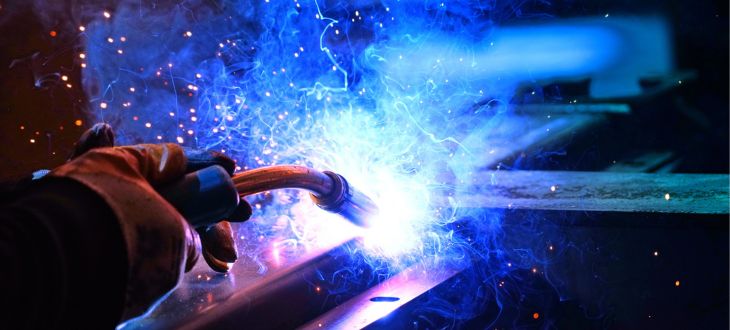Cast iron is a common material in construction and manufacturing with its excellent durability and heat retention. However, cast iron presents a unique set of challenges when it comes to welding. This blog post will explore whether you can weld cast iron and the difficulty level of the process, address frequently asked questions, and discuss the pros and cons of welding this complex material.
Can You Weld Cast Iron?
The simple answer is yes, you can weld cast iron, but it’s more complex than welding most other metals. Cast iron’s chemical composition — typically high carbon content — makes it more brittle and less ductile, making it susceptible to cracking when heated or cooled rapidly. Welding cast iron requires careful heat management and specialized techniques.
Difficulty Level of Welding Cast Iron
Welding cast iron is generally considered challenging, primarily due to its sensitivity to thermal shock and tendency to crack. The skill level required is higher than that needed for welding more forgiving materials like mild steel. A welder must have a good understanding of the different grades of cast iron and appropriate welding methods.
Preheating
One critical technique in welding cast iron involves preheating the entire piece to about 500-1200 degrees Fahrenheit (the exact temperature depends on the specific alloy). Preheating helps mitigate the risk of thermal shock.
Choosing the Right Welding Method
The most common methods for welding cast iron are:
- Shielded Metal Arc Welding (SMAW):Uses nickel electrodes, also known as stick welding.
- Gas Tungsten Arc Welding (GTAW):Also known as TIG welding, using a nickel alloy filler.
- Oxy-Acetylene Welding:A traditional method that provides precise heat control.
Cooling Down
Cooling must be controlled and slow. After welding, the cast iron often needs to be covered with an insulating material to slow the cooling process and prevent the formation of new stresses and cracks.
Frequently Asked Questions About Welding Cast Iron
What types of cast iron can be used to weld?
Gray cast iron, ductile iron, and malleable iron can all be welded using the proper techniques. White cast iron, however, is generally considered too brittle to weld effectively.
Can I use a standard MIG welder to weld cast iron?
MIG welding can be used, but it’s not typically recommended due to less control over heating. If used, a nickel-based wire is preferred.
What are the best electrodes to use for welding cast iron?
Nickel-based electrodes are generally the best choice due to their compatibility with cast iron’s thermal expansion and contraction rates.
Do I need to do anything after welding cast iron?
Yes, post-weld heat treatment is often recommended to relieve stresses caused by the welding process and to reduce the risk of cracking.
The Pros and Cons of Welding Cast Iron
The Pros
- Repairability: Welding can repair expensive or irreplaceable cast iron components.
- Restoration: Enables the restoration of historic or antique iron pieces.
- Strength: If done correctly, welding can restore the full strength of the cast iron.
The Cons
- Skill Requirement: Requires high skill and extensive experience to perform correctly.
- Cost: The process can be more costly due to the need for specialized materials (like nickel rods) and equipment.
- Risk of Damage: There is a high risk of causing further damage if not done correctly.
Tips for Successful Cast Iron Welding
There are many tips for cast iron welding, including:
- Assess the Type of Cast Iron: Knowing whether you’re working with gray, malleable, or another type of cast iron can dictate the most appropriate welding technique.
- Clean the Weld Area Thoroughly: Any contaminants can cause defects in the weld, so ensure the area is clean before you start.
- Use Appropriate Filler Material: A nickel-based filler material is best for welding cast iron because it offers the most flexibility and strength.
- Preheat and Post-Cool Slowly: Avoid thermal shock by managing the temperature carefully throughout the process.
- Seek Expert Advice if Unsure: Consulting with an experienced welder can provide insights and help avoid costly mistakes.
Welding cast iron is possible, but it requires a sophisticated approach compared to more straightforward welding tasks. The challenges primarily stem from the material’s susceptibility to heat-induced stress and brittle nature. However, with the right skills and techniques, welding cast iron can effectively repair or restore critical components. Understanding the material properties, proper preparation, and following best practices are key to success for those undertaking such tasks. Whether you are a hobbyist or a professional, mastering the art of welding cast iron is a valuable and rewarding skill in metal fabrication.
Visit Tampa Steel & Supply for Quality Metal and Metal Processing Services
Do you need help with metalworking and keeping your metal fresh? The experienced professionals at Tampa Steel & Supply are here to help. We provide the highest quality of services to our customers.
Request a Quote Online
Or Call Tampa Steel & Supply at (813) 241-2801

